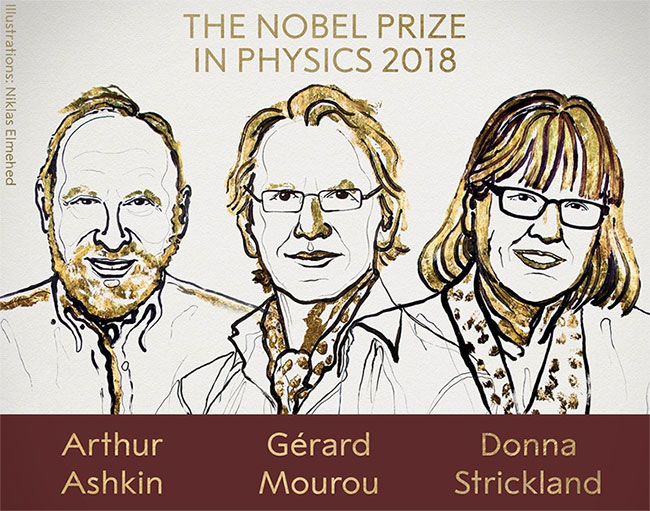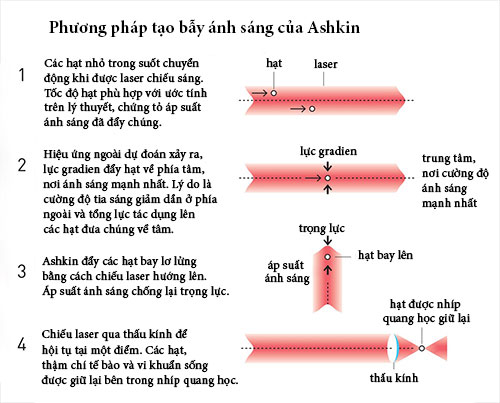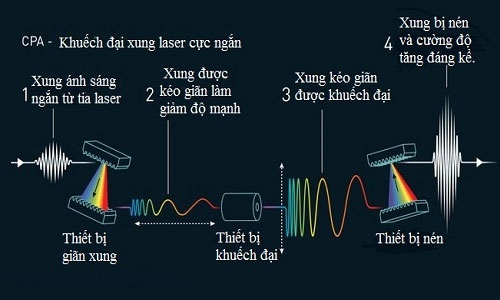The invention of laser won the Nobel Prize in Physics 2018
An American scientist and two Canadian scholars won the 2018 Nobel Prize in Physics with a prize worth one million dollars.
The 2018 Nobel Prize in Physics was awarded to researcher Arthur Ashkin, Gérard Mourou and Donna Strickland for groundbreaking inventions in the field of laser physics, according to the Guardian. The award was announced by Göran K. Hansson, General Secretary of the Royal Swedish Academy of Sciences at 4:55 PM Hanoi time. Award-winning scholars will win a $ 1 million reward.

The Nobel laureate will be awarded an 18K gold medal.(Photo: Phys.org).
Arthur Ashkin , an American physicist, was awarded half the prize for his discovery of optical tweezers , a kind of light trap that allows light to control small particles. Ashkin's optical tweezers secure particles, atoms and molecules with laser fingers. It can test and control viruses, bacteria and other living cells without hurting, creating opportunities to observe and control living organizations.

Steps to perform light traps.(Photo: Royal Swedish Academy of Sciences).
Two physicists Gérard Mourou (French) and Donna Strickland (Canadian) received the remaining half for the method of creating super-short optical pulses with intense intensity . This technique has the name of Amplifying ultra-short laser pulse or CPA . Sharp laser beams can cut or drill holes through various materials with extremely high precision, even with living matter. The technique helps make eye surgeries for millions of people every year.

Explanation of the method of amplifying extremely short pulse laser.(Royal Swedish Academy of Sciences).
This year's Nobel Prize winner has revolutionized laser physics, helping researchers discover microscopic objects and the process is fast. These extremely precise devices open up new areas of research, with many applications in industry and medicine.
Strickland at the University of Waterloo, Ontairo, became the first woman to win the Nobel Prize in Physics since Maria Goeppert Mayer received this honor in 1963 for research on nuclear shell structure. She is the third woman in history to win the prestigious Nobel Prize in Physics.
Last year, the award was given to three researchers Rainer Weiss, Barry Barish and Kip Thorne with the discovery of gravitational waves, ripples in the space-time field, generated by intense events such as wax black holes import.
Nobel is an international award established by the Nobel Foundation in Stockholm in 1901 based on the assets of Alfred Nobel, Swedish inventor and businessman.
The award is awarded annually to outstanding individuals and organizations in the fields of Medicine, Chemistry, Physics, Literature and Peace.
In 1968, the Swedish Central Bank created the Swedish Bank Prize for Economic Science in honor of Nobel, also known as the Nobel Prize in Economics. Each award includes a medal, a personal certificate and a bonus. From 1901-2017, the prize was awarded 585 times to 923 individuals and organizations around the world.
- Three light experts won the Nobel Prize in Physics
- Rare information about the first female scientist to win the Nobel Prize in Physics after 55 years
- Wikipedia's Nobel laureate refused to set up a site because it was not popular
- Why are Nobel Prize recipients getting older?
- Nobel history and things to know
- Gravitational wave discovery work won the 2017 Nobel Prize in Physics
- The Nobel Prize is not in the Nobel's 'vision'
- Inventing CCD won the 2009 Nobel Prize in Physics
- Japanese scientist won the 2014 Nobel Prize in Physics
- The only scientist twice won the Nobel Prize in Physics
- Ig Nobel 2013: Applause is breaking the law to win peace
- The 2012 Nobel Prize for Literature is about to have an owner
 Vietnam 5th Asian champion on fuel-efficient vehicles
Vietnam 5th Asian champion on fuel-efficient vehicles We can read all NASA studies completely free of charge
We can read all NASA studies completely free of charge Singer and songwriter Bob Dylan won the 2016 Nobel Prize for Literature
Singer and songwriter Bob Dylan won the 2016 Nobel Prize for Literature Scientific revolution in Asia
Scientific revolution in Asia